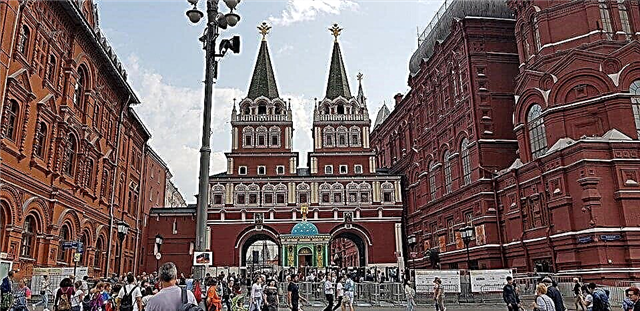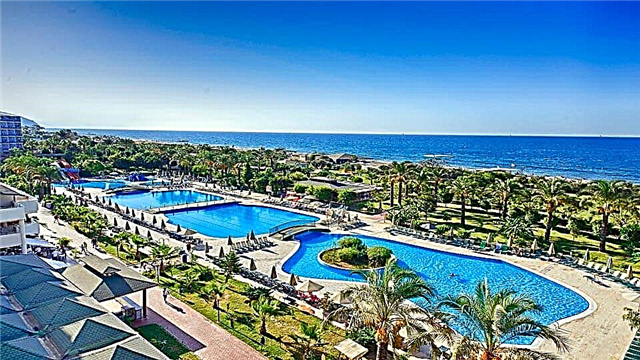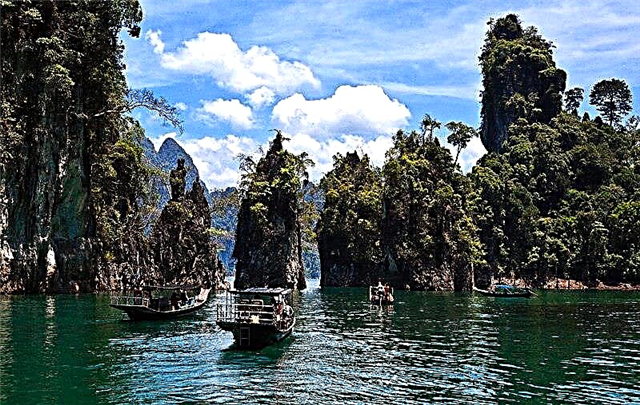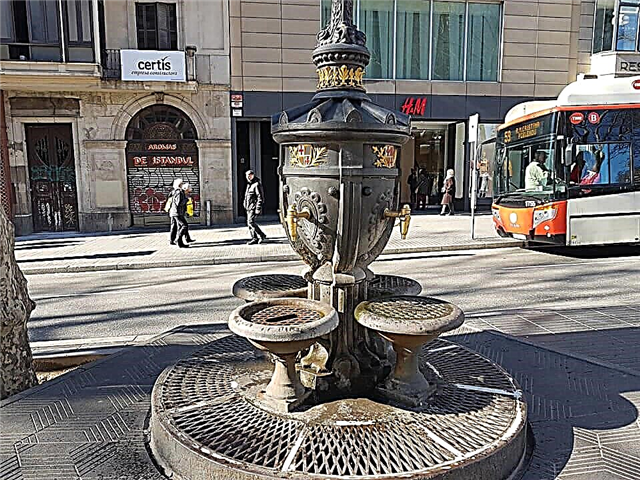The capital of Catalonia, located on the Mediterranean coast, geographically belongs to Spain, but openly demonstrates its individuality and independence from Madrid. Barcelona is an open-air museum, a monument to human entrepreneurship and a fantastic world in which distinctive streets and squares are full of architectural ensembles of different eras and styles. The main pedestrian artery of the city is La Rambla. Framed by a narrow strip of carriageway, it stretches from the Old Port to Plaza Catalunya. The most famous street in Barcelona is full of carefree fun and joy.
History

In the 8th century, instead of today's favorite boulevard by tourists and locals, there was the bed of the Kagalel River. The water flowing down from the mountain cut through the city and flowed into the Mediterranean Sea. In the summer, the river dried up, forming a ditch, and in the spring it was again filled with floods. The Catalans called this place "rambla", which means dry land. In the XIV century, a powerful wall was erected along the left bank of the Cagalel, serving to protect residential areas from robber raids.
The river was enclosed in an underground pipe, and the ditch was filled up. Since then, the active urbanization of Barcelona began. The only street leading to the sea coast was called La Rambla. Monasteries, churches, corps of novices of various religious orders appeared on it, and there was also a lively trade here.
In the 18th century, with the loss of its defensive function, the fortress wall was demolished. According to the decree of the ruling nobility of Barcelona, all monasteries on La Rambla were closed. The lands confiscated from the sanctuaries were sold to new owners, who built luxurious mansions and hotels. Military engineer Pedro Sermeño created a project for the improvement of the territory, taking as a basis the urban baroque style. La Rambla, lined with plane trees, has become a popular destination for walks and social gatherings.
Length of Barcelona's main street
The total length of La Rambla is over 1.5 kilometers. For centuries, Catalans and visitors to Barcelona have flocked to this busy avenue. The broad street is conventionally divided into five sections. Closer to the port, various entertainment venues are concentrated, followed by a zone of shops, restaurants, a flower market and a bird market. Tourists on the boulevard have the opportunity to get acquainted with local traditions and customs along the entire length of La Rambla.
What to see
La Rambla gives you an insight into the essence of the Catalan lifestyle. Day and night, the boulevard is filled with crowds of people who are entertained by dancers, musicians, magicians, painters, mimes and actors depicting living sculptures. Buildings with beautiful facades rise along the alley, framed by shady trees. There are also tables of street cafes, flower, souvenir stalls and a grocery market.
Rambla Canaletes

The first section of the famous boulevard, La Rambla de Canaletes, begins from Plaza Catalunya. There is a cast-iron well installed in the second half of the 19th century. Drinking fountains are located in the lamppost housing. They are a small vessel with taps. The source is credited with magical properties.
If a person, wishing to quench his thirst, heats water from him, then he will certainly visit the capital of Catalonia again. It is the traditional meeting place for the happy Barcelona fans who are passionately celebrating the victories of their favorite team.
Rambla Teachings

The second section of La Rambla de Estudis is named after the first university in Barcelona, established in the 16th century. The building of the educational institution was dismantled in the middle of the 19th century. Walking along this section of the boulevard, you can see the Baroque Church of Our Lady of Bethlehem, which suffered significant destruction during the 1936 Civil War. The side façade of the basilica overlooking La Rambla is tiled and reinforced with buttresses. The hall of the one-nave church with a rectangular apse and ten chapels is decorated with an arched gallery, columns and sculptures of saints.
La Rambla de Estudis is dominated by beautiful old buildings, the facades of which are decorated with bas-reliefs, pilasters, sculptures and balustrades. One of these architectural structures houses the popular "Poliorama" theater. You can always watch a flamenco show here. A clock is built into the facade of the building, showing the official Catalan time.
Rambla of Flowers
La Rambla de Flores (Rambla of Flowers) forms a beautiful part of Barcelona's main street. Countless flowers emit fragrance, sparkle in the sun and await their customers. Since the 19th century, Barcelona residents have come here for bright bouquets and seeds. Not far from stalls with fragrant plants is one of the most luxurious palaces of La Rambla, which is the pearl of Barcelona's Baroque architecture - the Palace of the Viceroy. The mansion was erected in 1775 for the governor of Peru, the Marquis Manuel de Amat, who, after returning to Barcelona, did not live long in his house. His wife remained the sole owner of the pompous apartment.
The majestic facade of the palace is decorated with pilasters, window frames with stucco molding and graceful balconies with wrought iron bars, framed by sculptures. Ornate decorative brackets support a large balustrade with twelve vases. Today, the palace hosts exhibitions of contemporary art.

The main attraction of the Rambla of Flowers is the popular Boqueria market, founded in 1840. The bazaar offers a wide range of products representing the exquisite delicacies of Catalonia - vegetables, fruits, fish and meat. The shopping arcade with 8,000 counters is located under a metal roof, which gives the market an original look.
Rambla of the Capuchins
The central part of Barcelona's famous street is the Rambla of the Capuchins, the beginning of which is marked by tiled mosaics decorating the pavement. The name of this section of the boulevard is associated with the old monastery of the Capuchin brotherhood. Noteworthy is the expressive building of Bruno Cuadros, where the umbrella store was previously located. Exotic decorative elements are visible on its facade - a Chinese dragon, cast-iron umbrellas, fans, enamel windows with Japanese prints.

The Rambla of Capuchins is home to one of the best opera houses in Europe - Liceu, which characterizes the cultural and social life of Barcelona. The theater building, built in 1847, was subjected to severe fires several times, which completely destroyed the luxurious interiors of the halls. Financial support from Catalan entrepreneurs helped to quickly restore the Liceu. Today's interior decoration impresses with its pomp: crystal chandeliers, marble staircase, velvet armchairs, ceiling with stucco molding.
The list of attractions of the Rambla of the Capuchins is significantly supplemented by the ancient theater of Barcelona - "The Principal", founded in the 16th century and still retaining its original appearance. The first secular musical performances were given here.
Rambla of Saint Monica
The southern section of the promenade boulevard is the Rambla of Saint Monica, which got its name from the monastery of the same name, which has now been transformed into an Art Center. There is a spacious covered gallery behind the modest facade of the building. The white walls and high ceilings of the former monastery premises offer unlimited possibilities for displaying large paintings by contemporary Catalan artists.There is also a library and an educational center here.

On the other side of the Rambla of Saint Monica, in a small alley, there is a wax museum, which displays more than 300 historical characters, as well as various creatures of human fantasies (a spaceship, a cave with primitive people, a pirate schooner and much more). The street leads to the marina with a view of the sea. In the center of the square rises one of the symbols of Barcelona - a monument to Christopher Columbus, crowning a sixty-meter column. The monumental statue was installed in 1888. There is an elevator inside the building that takes tourists to the observation deck.
Pickpockets - the scourge of the Rambla

Boulevard La Rambla creates the feeling of a year-round holiday. About 10 million people pass through Barcelona's main pedestrian street every year. Unsurprisingly, this is the perfect spot for pickpockets who operate professionally and in an organized manner, even in front of the police patrol. In order not to lose their wallet and other valuable things, tourists should be extremely careful. Fraudsters are quite inventive, work in groups and outwardly do not give rise to suspicion.
Where is the boulevard and how to get there
La Rambla originates from Plaza Catalunya, which is the intersection of many modes of transport. This is the very center of the city. You can get to the main boulevard of Barcelona by buses No. 9, No. 14, No. 16, No. 17, No. 42, No. 55, No. 59. There are three metro stations along the street - Catalunya, Liceu and Drassanes.











